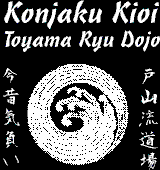 |
Toyama Ryu Batto Do Konjaku Kioi Dojo (Ancient and Modern Fighting Spirit Dojo) |
5980 66th St N Suite M St Petersburg FL 33709 Email: info@toyama-ryu.com Phone: 727-329-9679 |
|
Home
|
Respect for the KatanaI am not fond of the saying that the katana was the soul of the samurai or that samurai stored their soul in their katana. I do not think it accurately conveys the concept. The Japanese have the belief that everything has a spiritual aspect. That is true for a rock, a person, or a sword. They believe that the spirit of a sword is influenced by the sword smith and the owners of a sword. A great example is the way the Japanese feel about blades made by Okazaki Masamune and Sengo Muramasa. Both these sword smiths were known for the quality of their work, but while Masamune blades are considered in revered manner, Muramasa blades are considered bloodthirsty. It is thought that the swords took on the nature of their maker. Even today Masamune blades are worth much more than Muramasa blades even if the quality of the workmanship can be considered equal. The deeds and miss-deeds of a samurai would influence the spiritual aspect of their sword. I think anyone would consider a sword stored in a shrine for the last 400 years differently than one recently used to commit murder. I have a huge amount of respect for katana that belong to me, belong to others, or are awaiting an owner in the shop. While I do not defend my life with a sword, I use them several times a week in my training. Failure of sword (or my swordsmanship) can result in serious injury or death to me or those around me. This is true when Iím practicing tameshigiri or just cleaning a sword. I think it is pretty natural to have respect for any object that can do that much damage to you. A real katana is a serious investment. It is not some $19 flee market replica. For the samurai this was even more true than today. Students of the sword tend to own the best they can afford. Choosing the right sword is a difficult task. I always let people feel and swing katana before they purchase them in the shop. Picking the right katana is a personal decision. Usually the student picks the sword and sometimes I think the sword picks the student. These swords are all hand made - so every one of them is slightly different. After getting a new sword, all the students in the dojo continue to personalize their katana. This may be a simple as changing the sageo cord (cord that attaches the saya / scabbard to the obi / belt) or tsuba (guard). A katana requires constant maintenance. They have to be cleaned and oiled or they will rust. They also have to be constantly inspected for damaged mekugi pins (bamboo pin that holds the handle on the blade) or hidden corrosion. They are subject to damage from use, the weather, and even time. We are constantly taking care of our swords. This is true today and for the samurai. Failure of any component of your sword can cost you your life. That is true today if you are practicing swordsmanship or for the samurai who could need their sword to defend themselves. With the cost of the investment and the constant maintenance required, it should no be surprising that sword students of today and the samurai of the past were a bit paranoid about their katana. We never handle a katana without the ownerís permission and we always handle them with care. The concept that a katana must draw blood before being sheathed comes from stories surrounding some of those bloodthirsty Muramasa blades. Katana can be extremely sharp and will easily slice deep. We are constantly warning people that the katana are sharp, but they insist on feeling the edge for themselves. That has made a first-aid kit an essential part of the sword shop. When students become too comfortable with their katana, they end up getting bloody reminders from their katana. It is not a toy and should never be taken for granted. When I sharpen a katana, the edge wants to cut you with the slightest pressure. Iíve cut myself to the bone not paying attention. Even 300 year old antique blades will cut just as well today. A katana is a tool. It was for the samurai and today it is the same for students of Japanese Swordsmanship. It is a tool, but a tool that can easily cost you a finger, or even your life. It is a tool that was a serious investment and requires constant care. If we act a bit weird about our katana, I hope everyone else understands. If you follow the path of the samurai, Iím sure you do. For everyone else - there is one simple rule - Don't touch my katana! - Mike Femal |
Copyright © 2006 by Konjaku Kioi Toyama Ryu Dojo, All rights reserved.
Samurai Swords
Iaito (Practice Swords)
Shinken (Cutting Swords)
Wakizashi (Short Swords)
Tanto (Daggers)
Japanese Weapons
Maintenance
Uniforms
Sharpening
Sword Repair
Martial Arts
Dictionary Your Name in Japanese
Dojo Stories
Tatami Targets
